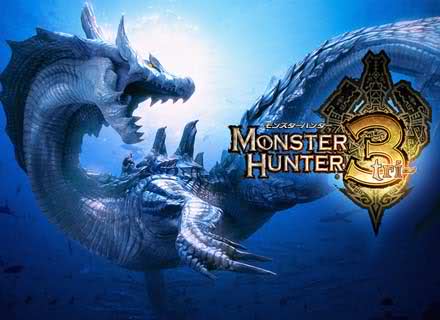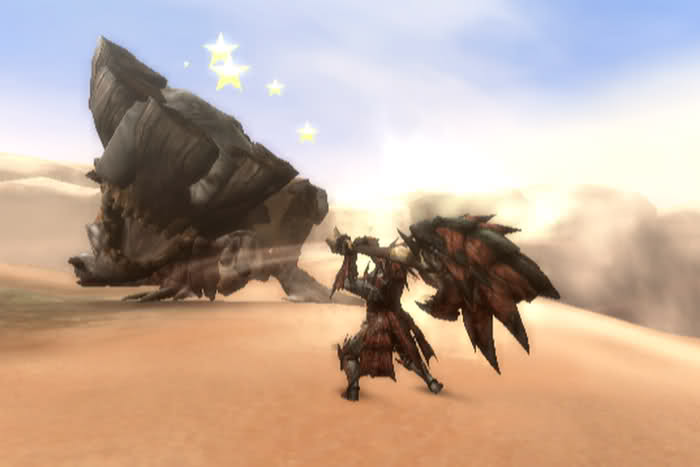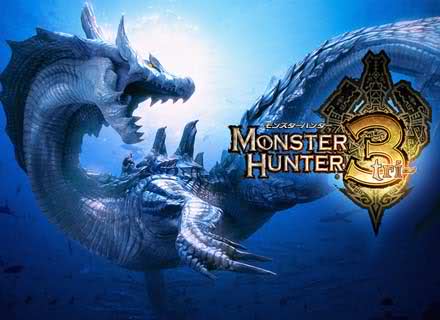 Editor’s note: Like Shiren the Wanderer before it, Capcom’s latest Wii title attempts to straddle the line between hardcore and casual gaming audiences. Will it be successful? I’m certainly enjoying my time with the game, and that’s not at all related to how much it reminds me of Demon’s Souls. Really! -Rob
Editor’s note: Like Shiren the Wanderer before it, Capcom’s latest Wii title attempts to straddle the line between hardcore and casual gaming audiences. Will it be successful? I’m certainly enjoying my time with the game, and that’s not at all related to how much it reminds me of Demon’s Souls. Really! -Rob
Monster Hunter Tri is a hard game about killing immense, brutal creatures and carving useful parts from their bodies. You craft armor from their hides and swords from their bones, then wield your grisly gear as you hunt ever more immense, more brutal animals.
MH3 is also charming, encouraging, and thoroughly cute.
You can’t pin down MH3 by labeling it casual or hardcore. Its battles play out in real-time, requiring the same rolling, blocking, and precise striking skills that games like God Hand or Demon’s Souls demand; at times, MH3 pits its players against bosses as merciless as their counterparts in those famously tough games. Yet its world is colorful, the characters are cheerful, and several time-based grinds (a farm, a fishing fleet, a visiting trader) recall casual games.
To me, the “hardcore” tag implies a sensibility as well as a level of difficulty. Games aimed at the hardcore market are often self-consciously grim in their presentation of violence, like the Gears of War or Ninja Gaiden games, or the wonderfully gloomy Demon’s Souls. Even a cartoonish title like God Hand has an aggressive, distinctly masculine sense of humor.
Despite its hardcore challenge, MH3’s attitude makes it an odd fit for this group. Most of the NPC dialogue (and there’s a lot of it) is chipper and jokey. Characters make Zeldaesque greeting noises (which are either gibberish or short bursts of Japanese — I don’t know) rather than speaking the lines that appear onscreen. There’s also a race of talking cats that seems hellbent on making even worse puns than the bear in Persona 4.

MH3’s particular genius is to alleviate the frustration that accompanies a mercilessly difficult game by employing both goofy humor and distraction. When you hit the run button regularly, your character assumes a typical, eyes-forward, determined posture; however, when you start running near a large monster, the animation changes to a headlong, “oh-shit-oh-fuck” sprint — with your arms flailing and head whipping from side-to-side to look behind you.
When you die, you watch two mewling cats haul your body back to camp on a cart, then brusquely dump you in the dirt. When the game treats your death with such irreverence, it’s hard to take it seriously yourself.
And then the game holds an element of distraction. When you get tired of grinding the same boss monsters to collect an armor set, you can decorate your house, upgrade the farm and collect items that grew there while you were out hunting, or give special items to the fishing fleet and send it out to collect yet more resources for you.
You would need a chart to untangle all the little systems that feed into one another and eventually lead to better gear. These “casual” systems work with the game’s playful tone to draw you back in when you might otherwise burn out.
I’m not predicting that Monster Hunter’s unique cocktail of difficulty and whimsy will prove as successful in the U.S. as it has in Japan. It’s an odd fit for the Wii audience, which isn’t receptive to difficult games. It also pretty much requires a Classic Controller, as the Wiimote-Nunchuk control scheme is awful.
Regardless of potential sales, though, MH3 stands as a potent blend of genres and styles. Games are too often content to recycle genre archetypes — yet more bald space marines — rather than find a style of their own. MH3 is an odd, important game, and it deserves to be recognized.


